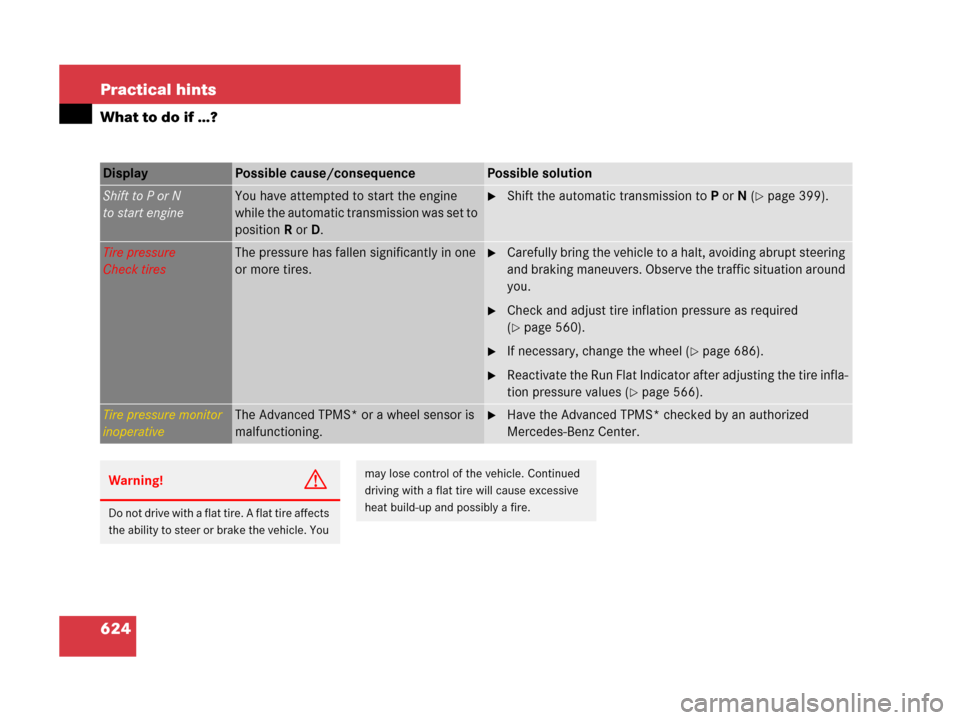Page 610 of 761

609 Practical hints
What to do if …?
Warning!G
Each tire, including the spare (if provided),
should be checked monthly when cold and
inflated to the inflation pressure recom-
mended by the vehicle manufacturer on the
vehicle placard or the tire inflation pressure
label. (If your vehicle has tires of a different
size than the size indicated on the vehicle
placard or the tire inflation pressure label,
you should determine the proper tire infla-
tion pressure for those tires).
As an added safety feature, your vehicle has
been equipped with a tire pressure monitor-
ing system (TPMS) that illuminates a low tire
pressure telltale when one or more of your
tires is significantly under-inflated. Accord-
ingly, when the low tire pressure telltale illu-
minates, you should stop and check your
tires as soon as possible, and inflate them to
the proper pressure. Driving on a significant-
ly under-inflated tire causes the tire to over-
heat and can lead to tire failure.
Under-inflation also reduces fuel efficiency
and tire tread life, and may affect the vehi-
cle’s handling and stopping ability. Please
note that the TPMS is not a substitute for
proper tire maintenance, and it is the driv-
er’s responsibility to maintain correct tire
pressure, even if under-inflation has not
reached the level to trigger illumination of
the TPMS low tire pressure telltale.
USA only:
Your vehicle has also been equipped with a
TPMS malfunction indicator to indicate
when the system is not operating properly.
The TPMS malfunction indicator is com-
bined with the low tire pressure telltale.
When the system detects a malfunction, the
telltale will flash for approximately
one minute and then remain continuously
illuminated. This sequence will continue
upon subsequent vehicle start-ups as long
as the malfunction exists. When the mal-
function indicator is illuminated, the system
may not be able to detect or signal low tire
pressure as intended.TPMS malfunctions may occur for a variety
of reasons, including the installation of
replacement or alternate tires or wheels on
the vehicle that prevent the TPMS from
functioning properly. Always check the
TPMS malfunction telltale after replacing
one or more tires or wheels on your vehicle
to ensure that the replacement or alternate
tires and wheels allow the TPMS to continue
to function properly.
Page 625 of 761

624 Practical hints
What to do if …?
Display Possible cause/consequencePossible solution
Shift to P or N
to start engineYou have attempted to start the engine
while the automatic transmission was set to
position R or D.�Shift the automatic transmission to P or N (�page 399).
Tire pressure
Check tiresThe pressure has fallen significantly in one
or more tires.�Carefully bring the vehicle to a halt, avoiding abrupt steering
and braking maneuvers. Observe the traffic situation around
you.
�Check and adjust tire inflation pressure as required
(
�page 560).
�If necessary, change the wheel (�page 686).
�Reactivate the Run Flat Indicator after adjusting the tire infla-
tion pressure values (
�page 566).
Tire pressure monitor
inoperativeThe Advanced TPMS* or a wheel sensor is
malfunctioning.�Have the Advanced TPMS* checked by an authorized
Mercedes-Benz Center.
Warning!G
Do not drive with a flat tire. A flat tire affects
the ability to steer or brake the vehicle. You
may lose control of the vehicle. Continued
driving with a flat tire will cause excessive
heat build-up and possibly a fire.
Page 665 of 761

664 Practical hints
What to do if …?
Display Possible cause/consequencePossible solution
Tele Aid
inoperativeOne or more main functions of the Tele Aid
system are malfunctioning.�Have the Tele Aid system checked by an au-
thorized Mercedes-Benz Center.
Tire pressure
Caution, tire defectVehicles with Advanced TPMS*:
One or more tires are deflating.�Carefully bring the vehicle to a halt, avoiding
abrupt steering and braking maneuvers.
�Engage the electronic parking brake
(
�page 395).
�If necessary, change the wheel (�page 686).
Caution
Tire defectVehicles with Advanced TPMS*:
One or more tires are deflating. The respec-
tive tire is shown in the multifunction dis-
play.�Carefully bring the vehicle to a halt, avoiding
abrupt steering and braking maneuvers.
�Engage the electronic parking brake
(
�page 395).
�If necessary, change the wheel (�page 686).
Warning!G
Do not drive with a flat tire. A flat tire affects
the ability to steer or brake the vehicle. You
may lose control of the vehicle. Continued
driving with a flat tire will cause excessive
heat build-up and possibly a fire.
Page 666 of 761

665 Practical hints
What to do if …?
Display Possible cause/consequencePossible solution
Tire pressure
Check tiresVehicles with Advanced TPMS*:
The pressure is too low in one or more tires.�Carefully bring the vehicle to a halt, avoiding
abrupt steering and braking maneuvers.
�Engage the electronic parking brake
(
�page 395).
�Check and adjust tire inflation pressure as
required (
�page 561).
�If necessary, change the wheel (�page 686).
Check tiresVehicles with Advanced TPMS*:
The pressure is too low in one or more tires.
The respective tire is shown in the multi-
function display.�Carefully bring the vehicle to a halt, avoiding
abrupt steering and braking maneuvers.
�Engage the electronic parking brake
(
�page 395).
�Check and adjust tire inflation pressure as
required (
�page 561).
�If necessary, change the wheel (�page 686).
Warning!G
Do not drive with a flat tire. A flat tire affects
the ability to steer or brake the vehicle. You
may lose control of the vehicle. Continued
driving with a flat tire will cause excessive
heat build-up and possibly a fire.
Page 667 of 761
666 Practical hints
What to do if …?
Display Possible cause/consequencePossible solution
Wheel sensor(s)
missingOne or more sensors malfunction (e.g. bat-
tery in one or more wheel sensor is empty).
One or more wheels without wheel sensors
mounted (e.g. spare tire).
No pressure value is shown on the multi-
function display for the tire in question.�Have the Advanced TPMS* checked by an
authorized Mercedes-Benz Center.
�Have the wheel sensors installed by an
authorized Mercedes-Benz Center.
The tire pressure for the respective tire is
shown in the multifunction display after a few
minutes driving.
Tire pressure
Please rectifyVehicles with Advanced TPMS*:
The pressure is too low in one or more tires.
Or the tire pressures of the individual
wheels differ too radically from one anoth-
er.�Check and adjust tire inflation pressure as
required (
�page 561).
Page 710 of 761
709 Technical data
Parts service
Warranty coverage
Identification labels
Layout of poly-V-belt drive
Engine
Rims and tires
Electrical system
Main dimensions and weights
Fuels, coolants, lubricants, etc.
Page 719 of 761

718 Technical data
Rims and tires
!Only use tires which have been tested and
approved by Mercedes-Benz. Tires approved by
Mercedes-Benz are developed to provide best
possible performance in conjunction with the
driving safety systems on your vehicle such as
ABS or ESP
®. Tires specially developed for your
vehicle and tested and approved by
Mercedes-Benz can be identified by finding the
following on the tire’s sidewall:
�MO = Mercedes-Benz Original equipment
tires
S63AMG and S65AMG:
Does not apply to all approved tires on AMG
vehicles. For information on tested and
approved tires for AMG vehicles, contact an
authorized Mercedes-Benz Center.
Using tires other than those approved by
Mercedes-Benz may result in damage that is not
covered by the Mercedes-Benz Limited
Warranty.
!Using tires other than those approved by
Mercedes-Benz can have detrimental effects,
such as
�poor handling characteristics
�increased noise
�increased fuel consumption
Moreover, tires and rims not approved by
Mercedes-Benz may, under load, exhibit dimen-
sional variations and different tire deformation
characteristics that could cause them to come
into contact with the vehicle body or axle parts.
Damage to the tires or the vehicle may be the
result.
iFurther information on tires and rims is
available at any authorized Mercedes-Benz
Center. A placard with the recommended tire in-
flation pressures is located on the driver’s door
B-pillar (
�page 553). Some vehicles may have
supplemental tire inflation pressure information
for driving at high speeds (
�page 559) or for ve-
hicle loads less than the maximum loaded
vehicle condition (
�page 568). If such informa-
tion is provided, it can be found on the placard lo-
cated on the inside of the fuel filler flap. The tire inflation pressure should be checked
regularly and should only be adjusted on cold
tires. Follow tire manufacturer’s maintenance
recommendation included with vehicle.
iThe following pages also list the approved
wheel rim and tire sizes for equipping your vehi-
cles with winter tires. Winter tires are not avail-
able as standard or optional factory equipment,
but can be purchased from an authorized
Mercedes-Benz Center.
Depending on vehicle model and the standard or
optional factory-equipped wheel rim/tire config-
uration on your vehicle (Appearance Package,
Sport Package etc.), equipping your vehicle with
winter tires approved for your vehicle model may
also require the purchase of two or four wheel
rims of the recommended size for use with these
winter tires. Contact an authorized
Mercedes-Benz Center for more information.
Page 720 of 761
719 Technical data
Rims and tires
Same size tires
ModelS 550
S 550 4MATICS 600
S 550 (Sport Package*)
S 600 (Sport Package*)S63AMG
S65AMG
Rims (light alloy)8.5 J x18 H28.5 J x18 H28.5 J x19 H2
Wheel offset1.69 in (43 mm)1.69 in (43 mm)1.69 in (43 mm)
All-season tires1
1Radial-ply tires.
255/45 R18 99H M+S ––
Winter tires1,2,3
2For use with snow chains contact an authorized Mercedes-Benz Center.3Not available as factory equipment.
255/45 R18 99H M+S.255/45 R18 99H M+S.255/40 R19 100V XL (Extra Load) M+S.